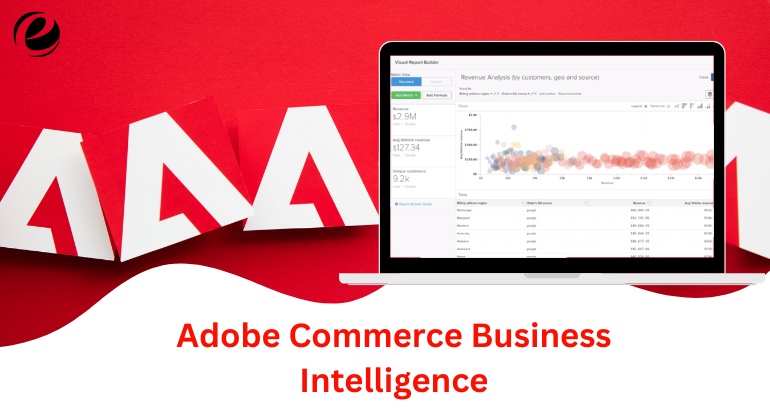Being faster than lightning, data generation demands a lot to get organized, accumulated, accessible, and manageable. Merchants always seek a data-driven approach that may crop up, ironing out issues relevant to huge data volumes.
Here Business Intelligence from Adobe Commerce (formerly Magento) comes into play, a single solution that can be a warehouse, pipeline, and even visualization tool, an all-in-one. It’s widely known for easing data gathering, analysis, and visualization that aid in driving better business insights, which leads to sound business decisions.
Here you will learn:
- How to integrate Adobe Commerce Business Intelligence into your business?
- How can Business Intelligence benefit various industries?
- What is the working of Business Intelligence?
- What are the challenges?
- How to overcome them, and more.
Stick to this post to know everything about Adobe Commerce Business Intelligence.
Understanding Adobe Commerce Business Intelligence
Adobe Commerce Business Intelligence is a cloud-based SAAS solution that every team member can make the best use of to save time and gain better insights. Besides, it easily connects all your systems, centralizes your data, and strengthens your business with a robust and friendly interface.
Also recognized as a part of data analytics, Business Intelligence (BI) includes data accumulation, analysis, and visual presentation. The chief role of BI is to ease data interpretation that simplifies the working ahead to create an informed decision.
With Magento BI (now Adobe Commerce BI), you can build data reports in three different ways depending on the type of analysis you need to conduct and your preference.
1. Visual Report Builder: One of the most popular data visualization methods is the visual report builder. It helps in the creation of charts, append metrics, and categorize your data with only a few clicks.
2. SQL Report Builder: It permits direct data query, view outcomes, and rapidly convert them into a chart.
3. Cohort Report Builder: This report builder helps save your report to a dashboard based on a specific date, like your signup date or first purchase. Furthermore, you can share it with your team just by clicking on the “save” button and choosing the dashboard you need to add it to. You only need to hit the share button, write the user name, edit the access rights, and save it to share it with your teammates.
This way, you can strengthen your teammates by creating as many reports as you want and sharing them across your company.
| BI As Data Pipeline & Data Warehouse Technology |
| Straight integrated with your Adobe database. |
| Find your consolidated data stored in a central cloud-based warehouse. |
| Works on full-stack, automated data replication technology. |
| Provides amazing data control and management. |
| BI Turns Data Into Value |
| Craft columns and join tables. |
| Customize your business metrics. |
| Use a report builder to build analyses. |
| Hold export power to extend data usage. |
| Query the whole data warehouse to catch up with specific outcomes. |
| BI Helps With a Whiteboard to Visualize |
| Convert your data to let you visualize |
| Unlimited dashboards to well-organized data. |
| Allow access to pre-built reports. |
| Offer various user permission tools to let users access specific resources. |
| Send analysis right in the user’s inbox. |

How Does Business Intelligence Work?
Business Intelligence platforms, like Adobe Commerce (Former Magento), bring your entire business data in one spot. Next, they store, sync, and showcase those facts from all your business operations in a cloud-based warehouse. From there, you can quickly analyze it and make profitable data-driven decisions.
Business Intelligence works as below:
- First, it integrates data from the sources and loads it into an analytics repository, be it a data warehouse.
- Next, it well-organizes the data sets into analytics data models to make them set for analysis.
- Then, professional BI analysts and business users run analytical queries.
- Ahead, the results of the queries are created into cloud-based dashboards, data visualizations, tables, bubble charts, graphics, online portals, and reports.
- Share deep insights with your team and business executives who use this data best for strategic planning and better decision-making.

Who Are The Typical Users of BI?
Well, commonly, business intelligence software is used in finance, sales, marketing, and operations. Across varied industry verticals, BI is acknowledged as a highly valuable asset because of its seamless adaptability in processes, predictions, and performance. Besides, eCommerce brands use BI to track their business performance.
Benefits of Using Adobe Commerce Business Intelligence
1. Easy-to-Use Dashboard
Using these dashboards, you will not find any issue in understanding your data and showcasing it across your business in a more accessible and engaging way on your BL platform.
2. Data-Driven Decisions
Using real-time and sales forecasting data, you can make sound decisions for your business that can let you catch up with an increased profit.
3. Enhanced Customer Experiences
Magento business intelligence processes the issues seamlessly and quickly using custom customer-service dashboards. Besides, it lets the users observe the associated deliveries, chats, and queries.
4. Reduced Manual Work
It automates the data tracking and reports compilation, freeing the users from gathering data from varied departments. Consequently, it helps boost the productivity of businesses.
5. Enhanced Internal Communication
In the presence of an interface that may allow any member to interact easily, your business’s structure can be optimized well. This leads to faster internal communication as every employee and manager can access essential information simultaneously.
6. Holistic View of Data
Adobe Commerce’s business intelligence provides a complete view of all its business data and operations, boosting efficiency.
7. Robust Data Warehouse
Holding the centralized and well-managed caliber of business intelligence plucks out all the possible hitches with a central solution that lets you analyze what’s most significant. Besides, people acknowledge it as a robust data warehouse that accumulates data from your systems and associates this detail with reactive data tables.
8. Business Performance Tracking
Based on the revenue distribution statistics, you can identify top-spending customer segments and top-performing categories. Additionally, BI permits you to track your website activity with an eye on customer abandonment and conversion rates.
9. Controlled Data Editing
Adobe Commerce business intelligence provides a wide range of permission levels to make sure data stays secured and regulated over analytics systems. Post assigning an administrator, you are free to edit stored data, dashboards, metrics, and reports.
10. Track Customer Behavior or Patterns
You can draw a holistic view of your customer interests and needs using the data on cart abandonment, product visits, and sales.
What are Business Intelligence Tools?
Formerly Magento, Adobe Commerce emerged with various business intelligence tools using which you can make beneficial business decisions based on your data analysis.
Let’s look into different BI tools:
1. Adobe Analytics
Businesses don’t need to fret about tracking their website performance and customer behavior, as Adobe Analytics does for them. Besides, using this Business Intelligence reporting tool, you can get deeper insights into your customer’s conversion rates and journeys and track the performance of the business’s revenue.
2. Magento Business Intelligence (MBI)
If you seek a tool that may provide you with advanced reporting and analysis potential, look no further than Magento Business Intelligence. Additionally, it can help you track your customer behavior, sales, and product performance.
3. Adobe Sensei
Also recognized as Adobe’s AI and ML platform, Adobe Sensei is best for analyzing customer data and offers personalized recommendations for content and products.
4. Data Warehouse
This Magento BI tool, Data Warehouse, allows businesses to store and manage data well in a centralized location. Thus, you catch up with advanced analytics powers, including predictive monitoring and data visualization.
Significance of Business Intelligence (BI) Tools
With BI tools, you can enhance everything, from strategy to execution. You can extract insights quickly and make better decisions by accumulating data in a single spot. Let’s unveil the importance of Adobe Commerce BI tools:
1. Reach Business Objectives
Organizations can track their business performance by evaluating their benchmarking process and acting on reporting insights.
2. Boost Workflow Efficiency
BI tools assist brands in digging out better insights that may lead to better decision-making surrounding business processes and strategies.
3. Data Gathering & Storage
As business data comes from varied sources, BI helps accumulate them in one place, mining it per the patterns that may provide better visualization.

Business Intelligence vs. Analytics – Let’s Clear the Confusion
Usually used interchangeably, Business intelligence and analytics hold minute differences. Let’s dig them out.
| Parameters | Business Intelligence | Business Analytics |
|---|---|---|
| Definition | Drive current business needs by analyzing the business’s history and present data. | Crop up with prospective business outcomes by analyzing past business data. |
| Target | Data Management | Data Analysis |
| Applications or Tools | BI tools offer insights into a company’s present performance over time. | Business analytics tools process business data to make better future decisions about improving operations to boost productivity. |
| Tools Used | SAP Business Objects, TIBCO, QlikSense, PowerBI | MS Office Tools, Word processing, Google Docs, MS Visio |
| Usage | Targets enterprise-wide reporting in varied teams and departments. | Analyzes an organization’s specific areas, like marketing or sales. |
| Used by | IT departments and their vendors. | Business departments and their consultants. |
Challenges of Business Intelligence
1. Training Expenses: Adobe Commerce Business Intelligence helps make better business decisions, but it demands good training to use it best and catch up with the best results.
2. Low BI Adoption Levels: Even post investing your time and money into your business intelligence software, it may go wasted if your team wouldn’t accept it. A low adoption level is one of the chief challenges that organizations usually encounter. Most employees hold the wrong thought that by getting aligned with an automated venture, they may no longer stay in their job. But this needs to be corrected. The thing is, automating business operations will save their time for other higher-valued jobs that will make them more valuable company assets.
3. Stick to a Specific Plan: While using Business Intelligence, your entire team needs to follow the plan crafted to resolve the issues they face with proper data utilization, leading to better data usage and value.
4. Choose The BI Right Consulting Partner: For accurate and fast analysis, consistent data strategy, and a unified data warehouse, mark the base. Without these forerunners, you can leave your data isolated in data silos like the missed opportunity.
So, to keep this from happening, you must hire a reliable BI consulting partner to assist you will a well-established robust infrastructure, handle data governance, and link your data warehouse with the competent BI tool.
5. Worse Data Visualization: Apparently, custom BI dashboards play a vital role in communicating complex data for deep insights and better decision-making. Though, a wrong choice of the dashboard may make your BI management out of shape.
You should know about all the types of dashboards before choosing for your business, like analytics dashboards to get a complete data view, operational dashboards for real-time updates about specific departments, or strategic ones to summarize crucial KPIs to the executives.
6. Issue of Data Quality: Proper data management strategy can assist in controlling data quality issues. In short, it’s responsible for dealing with the generated or collected data that leads to sound decision-making. So, you need to target that.
A chief data management component, data architecture assists in delivering top-quality details. One more component that you can take into account is data modeling. It will help you make your data suitable for analysis.
How Can You Use Magento/Adobe Commerce Business Intelligence?
Adobe Commerce BI service is a cloud-based platform on which you can accumulate and analyze statistical data of your eCommerce business. You can link your BI with your Magento system, as well as to any 3rd-party CRM database. In Magento Business Intelligence, an account can let you access five dashboards and almost 100 reports.
Magento Commerce clients can reap the benefits of business intelligence services by activating an account.
Getting Started with Adobe Commerce Business Intelligence
Are you looking to experience a seamless start with Adobe Commerce Business Intelligence? Here you go:
- Start with a secure sign-in and get assistance from across the organization.
- Be sure while bringing your business on board; you must make your staff engaged entirely in the beginning only.
- Make your BI team, whether small or big, needs to hold the BI experts.
- Set your business objectives with which you would like to measure your sales, logistics, and marketing performance.
- Remember to align your BI targets with your business goals and KPIs.
- Data preparation is essential, so from social to email, choose the apps, tools, and platforms you will be using ahead of time.
- Brainstorm about what you want to attain at last using BI. For that, you can keep track of the critical dependencies and milestones for marking your success.
How Can Emizentech Help in Integrating Adobe Commerce Business Intelligence into Your Business?
If you are looking for a custom Adobe BI quote meeting your specific business needs, get in touch with Emizentech today! We hold teams of certified Adobe Commerce experts who will assist you in reviewing your business requirements and will guide you through steps to take ahead to accomplish your objectives seamlessly.
- Help you store data in a single hub,
- Offer dedicated data analysis space,
- Showcase your data enticingly,
- Craft appealing visualizations using scatter charts and dynamic bubbles,
- Convert your data into striking reports and save them,
- Provide you with data control,
- Crop up with easy-to-use report builders, etc.

Conclusion
Business Intelligence tools help merchants accumulate customer data, analyze it, and visualize it efficiently to improve decision-making and meet the desired business goals.
Holding a business in this competitive market, you must stay exceptional to stay ahead of the curve. And for that, BI tools will play a crucial role. When you are set to get started with your business intelligence, choosing reliable BI tools is essential for your business.
If you have any confusion at this edge, you need assistance from BI experts, and for that, you can turn your head to Emizentech. The team is well-experienced in providing Adobe Commerce Business Intelligence services to worldwide clients today, experiencing ease in accumulating, analyzing, and visualizing customer data to make sound business decisions that help boost ROI.





 USA
USA UK
UK